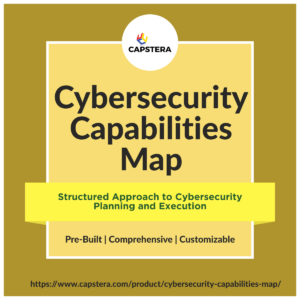
The ultimate guide to business architecture-led Cybersecurity transformation.
In our interconnected digital age, cybersecurity challenges have reached unprecedented complexity and sophistication. From phishing attacks to ransomware, organizations face an ever-expanding array of threats that can undermine their integrity, disrupt operations, and expose sensitive information. Governments, enterprises, and individual users all encounter risks that necessitate a vigilant approach to security. Cybercriminals continuously evolve their tactics, utilize emerging technologies, and targeting vulnerabilities in systems, rendering conventional security measures often inadequate.
Business Architecture Matters
Business Architecture serves as the structural blueprint of an organization’s business strategy, focusing on aligning, governance, and articulating strategic objectives. By utilizing key deliverables such as Capability Maps, Value Streams, and Business Data Models, Business Architecture enables organizations to gain insights into their operational landscape. This ensures that the architecture of the business is responsive and adaptable, supporting an environment where change can be managed effectively. The role of Business Architecture is not merely a conceptual framework but a practical tool that guides decision-making, resource allocation, and strategic planning.
The Strategic Imperative for a Structurally Sound Strategy and Cybersecurity Plan
Developing a structurally sound strategy for cybersecurity is not just an IT concern; it’s a business necessity. This strategy must extend beyond mere defense against known threats. It requires a profound understanding of the organization’s unique vulnerabilities, alignment with business objectives, and foresight to anticipate emerging risks. Integrating a robust cybersecurity plan within the overall business strategy ensures that security doesn’t become an isolated effort but a cohesive part of the organizational culture. This alignment recognizes the intertwining nature of technology and business operations, reinforcing a structure that can adapt and respond to an ever-changing threat landscape.
Business Architecture-led Cybersecurity Transformation
Cybersecurity transformation isn’t merely a process of implementing new technologies or practices. It’s a foundational change that requires a deep alignment with the core principles and structures of the business. Here is where Business Architecture plays an indispensable role. By grounding cybersecurity efforts in the essential architecture of the business, organizations ensure that their approach to security is not reactive but proactive. The utilization of Capability Maps, Value Streams, and Business Data Models provides a framework that allows for the clear identification of vulnerabilities, prioritization of threats, and allocation of resources in a manner that resonates with the broader business goals. This approach transforms cybersecurity from a peripheral concern to an integral business strategy and operational excellence component.
As the threats continue to evolve, the need for a robust cybersecurity plan has never been more urgent. The integration of Business Architecture within cybersecurity planning offers a pathway to align, assess, and fortify the defenses in harmony with the organization’s overarching goals. This holistic approach ensures that cybersecurity isn’t just about technology but is a strategic endeavor that empowers the business to thrive in a challenging digital landscape.
The Critical Role of Cybersecurity in Modern Business
Current Cybersecurity Landscape
The cybersecurity landscape is a complex and ever-changing arena. In today’s digitally connected world, threats emerge from various corners, including state-sponsored attackers, organized cybercrime rings, and individual hackers. These actors relentlessly seek to exploit vulnerabilities in systems, targeting not only large corporations but also small businesses and individual users. The constant evolution of technology has broadened the attack surface, making the protection of digital assets an ongoing battle.
Trends in Cyber Attacks
With the advancement in technology, cyber-attacks have also grown more sophisticated. Attacks such as phishing and ransomware remain prevalent, but new trends like Artificial Intelligence-powered attacks and Internet of Things (IoT) vulnerabilities are on the rise. The use of machine learning by cybercriminals to automate attacks and the exploitation of interconnected devices showcase the adaptive nature of modern cyber threats. These trends highlight the need for continuous vigilance, innovation, and adaptation in cybersecurity strategies.
Regulatory and Compliance Requirements
As cyber threats grow, so do the regulatory and compliance requirements surrounding them. Governments and international bodies are implementing stringent regulations to ensure that organizations are taking adequate steps to protect sensitive data and maintain privacy. Such efforts include the General Data Protection Regulation (GDPR) in Europe and the California Consumer Privacy Act (CCPA) in the U.S.. Non-compliance can lead to substantial fines and legal penalties, reinforcing the importance of aligning cybersecurity practices with legal mandates.
The Financial and Reputational Impact of Cyber Threats
Cyber threats carry a potential financial burden and a serious risk to an organization’s reputation. A single breach can lead to significant monetary loss through fines, lawsuits, and remediation costs. Beyond the immediate financial implications, the damage to a company’s reputation may have long-lasting effects, eroding trust among customers and partners. Building and maintaining trust is a delicate process, and the impact of a cyber incident can be a setback that takes years to overcome.
Why the “Whackamo” Approach to Cybersecurity Does Not Work
The “Whackamo” approach to cybersecurity, wherein threats are dealt with one at a time as they pop up, is a reactive and inadequate strategy. This method treats cybersecurity as a never-ending game, where new threats are merely smacked down as they appear without addressing the underlying vulnerabilities or systemic issues. It lacks a cohesive strategy, foresight, and adaptability, allowing cybercriminals to exploit new weaknesses continuously. This approach fails to recognize that cybersecurity is not just about dealing with individual threats but requires a comprehensive, proactive plan that aligns with the broader business goals and technology landscape.
The critical role of cybersecurity in modern business cannot be overstated. The current landscape demands a robust, proactive, and aligned approach that considers emerging trends, regulatory requirements, and cyber threats’ potential financial and reputational impacts. Relying on reactive strategies like the “Whackamo” approach only perpetuates vulnerabilities and fails to provide the holistic protection required in today’s complex digital environment. By understanding and addressing the intricacies of the cybersecurity landscape, organizations can foster a resilient defense that supports their overall business objectives.
Business Architecture-led Cybersecurity: A Strategic Approach
Definition and Core Components
 Business Architecture serves as the blueprint of an organization’s strategy and operation. It represents the fundamental organization of a business ecosystem, including its functions, processes, information, and technology. Here are its core components:
Business Architecture serves as the blueprint of an organization’s strategy and operation. It represents the fundamental organization of a business ecosystem, including its functions, processes, information, and technology. Here are its core components:
- Capability Maps: These provide a high-level view of what the organization does, offering an understanding of the capabilities required to execute the strategy. It highlights where investments need to be made, especially in areas concerning security.
- Value Streams: Value Streams represent the flow of information and materials from the initial request through delivery to the end customer. In the context of cybersecurity, understanding these streams is essential to identify potential vulnerabilities and ensure that security measures align with business value.
iii. Business Data Models: This includes representing the organization’s data relationships, rules, and policies. Understanding how data moves and connects is key to securing it and ensuring that sensitive information is handled appropriately.
- Cross Mapping between and other Entities: This involves aligning and integrating various components within the business architecture, ensuring that everything is interconnected. It provides a unified view that can help identify security needs, dependencies, and potential weaknesses in the system.
Aligning Business Strategy with Security Needs
Aligning business strategy with security needs is not a one-time exercise but a continuous process. It demands an in-depth understanding of the organization’s objectives, strengths, and weaknesses. The strategic use of Business Architecture helps identify the key areas where security needs to be robust, align them with business goals, and ensure that security measures don’t hinder the organization’s growth or innovation. It turns security from a stand-alone concern into an integrated aspect of overall business performance and sustainability.
Benefits of Business Architecture-led Cybersecurity Planning
- Holistic View: Business Architecture offers a comprehensive view of the organization, allowing for the identification of potential vulnerabilities across all aspects of the business.
- Strategic Alignment: By aligning cybersecurity measures with business goals, organizations ensure that security is a driving force behind business growth rather than a hindrance.
- Resource Optimization: By clearly identifying key capabilities and vulnerabilities, organizations can allocate resources more effectively, prioritizing areas with the highest risk.
- Enhanced Collaboration: Cross Mapping and integrated views facilitate better communication and collaboration between different departments, leading to a more cohesive approach to cybersecurity.
- Regulatory Compliance: Understanding the full scope of the business through Business Architecture aids in ensuring that all regulatory and compliance requirements are met, reducing legal risks.
- Adaptability: The dynamic nature of Business Architecture means that as the business grows or changes, the cybersecurity strategy can adapt in tandem, maintaining robust protection aligned with the evolving business landscape.
Business Architecture is not merely a theoretical concept but a practical tool that is instrumental in crafting a robust cybersecurity strategy. Its components, including Capability Maps, Value Streams, Business Data Models, and Cross Mapping, work in synergy to provide a holistic and aligned approach to cybersecurity. By integrating Business Architecture in cybersecurity planning, organizations can transform their security measures from isolated tactics into a strategic, adaptable, and comprehensive defense mechanism that supports and drives business success.
Leveraging Capability Maps for Cybersecurity Planning
Capability Maps are essential components of Business Architecture that enable organizations to understand their core functionalities and align them with strategic goals. This approach extends to cybersecurity, where Capability Maps act as vital tools in planning and implementing robust defenses.
Identifying Key Business Capabilities
Capability Maps visually represent an organization’s key functions, processes, and abilities. By breaking down the organization into its core capabilities, leaders can gain insights into what drives value and where vulnerabilities may lie. This identification process facilitates a comprehensive understanding of the business, allowing for targeted security measures that protect essential functions without hindering innovation or growth.
Mapping Security Needs to Cyber Capabilities
Understanding key business capabilities is just the starting point. Mapping security needs to these capabilities requires a strategic alignment between what the organization does and what it must protect. This mapping process ensures that security measures are not generic or disconnected but tailored to the specific functions and processes crucial to the organization’s success. By aligning security measures with capabilities, the organization ensures that protection is directly linked to business value.
Identifying and Prioritizing Security Investments
Once the organization has identified key capabilities and mapped security needs, the next step is prioritizing investments. Not all capabilities are equally important, and not all require the same level of protection. Using Capability Maps to identify where security needs are greatest, organizations can prioritize investments in areas that provide the greatest value or face the greatest risk. This focused approach ensures that resources are allocated effectively, maximizing protection without overextending budgets.
Case Studies and Best Practices
The application of Capability Maps in cybersecurity planning is not theoretical; various organizations have successfully employed it to enhance their security posture. Here are some case studies and best practices:
- A Financial Institution: A major bank used Capability Maps to identify critical customer-facing functions and align security measures to protect sensitive financial data. This alignment led to a more resilient security system that could adapt to changing regulations and threats.
- Healthcare Provider: A healthcare provider leveraged Capability Maps to understand the complex interactions between patient care, medical data, and compliance requirements. By mapping security needs to these core capabilities, they could implement targeted defenses that protected patient privacy without impeding care.
iii. Technology Company: A global tech firm utilized Capability Maps to identify innovation-driven capabilities and align security investments to protect intellectual property without stifling creativity. This alignment resulted in a flexible security strategy that supported rapid growth.
- Best Practices: Key best practices include engaging cross-functional teams in the mapping process, regularly updating Capability Maps to reflect changes in the business landscape, and using them as living documents that guide ongoing security planning and investment.
Leveraging Capability Maps is more than a tactical exercise; it’s a strategic approach that turns cybersecurity planning into a business-driven endeavor. By identifying key capabilities, mapping security needs, and prioritizing investments based on business value, organizations can create a security strategy that is robust, aligned, and adaptable. Case studies and best practices further illustrate the real-world impact of this approach, offering a clear path for others to follow. Capability Maps are not merely tools but vital instruments that transform cybersecurity from a technical challenge into a strategic asset that propels the organization forward.
Utilizing Value Streams
 Value Streams are vital components of Business Architecture, illustrating the flow of value through an organization, from the initial customer request to final delivery. When it comes to cybersecurity, Value Streams are instrumental in understanding the complexities of information flow and dependencies, allowing for strategic security planning.
Value Streams are vital components of Business Architecture, illustrating the flow of value through an organization, from the initial customer request to final delivery. When it comes to cybersecurity, Value Streams are instrumental in understanding the complexities of information flow and dependencies, allowing for strategic security planning.
Understanding Information Flow and Dependencies
Value Streams provide a comprehensive view of how information and materials flow through various stages of a business process. By analyzing these streams, an organization can identify the key touchpoints, dependencies, and interactions that are crucial to delivering value to customers. This understanding helps enhance efficiency and pinpoint areas where security needs to be robust to protect sensitive information and ensure uninterrupted flow.
Identifying Vulnerabilities and Risks in Business Processes
A detailed analysis of Value Streams reveals not only the smooth flow of value but also potential vulnerabilities and risks. Understanding the flow allows organizations to see where threats may exploit the system, whether it’s a weak link in the supply chain or a potential data breach point in a customer service process. By identifying these vulnerabilities, businesses can prioritize risk mitigation strategies, targeting areas where a security breach could have significant consequences.
Implementing Security Measures Aligned with Business Goals
Security implementation is not about creating barriers but building defenses that align with business goals. Utilizing Value Streams allows organizations to tailor security measures to protect the essential flow of value without creating unnecessary hindrances. By aligning security measures with the flow of information and materials, organizations ensure that defenses are well-positioned to guard against threats while supporting efficiency, customer satisfaction, and growth.
Real-Life Examples and Success Stories
The strategic use of Value Streams in cybersecurity is not just theoretical but has proven successful in various industries. Here are some real-life examples:
- Manufacturing Company: A global manufacturing company utilized Value Streams to identify key vulnerabilities in its supply chain process. By implementing targeted security measures, they could mitigate risks without affecting the efficiency of the supply chain.
- E-Commerce Platform: An online retailer leveraged Value Streams to understand the complete journey of customer information from login to checkout. This understanding led to the implementation of security protocols that safeguarded user data without compromising user experience.
iii. Government Agency: A government body used Value Streams to map the flow of sensitive information between departments. By identifying key touchpoints and dependencies, they created a secure information exchange system that complied with stringent regulations.
- Success Stories in Healthcare: Several healthcare providers have successfully applied Value Streams to safeguard patient information. By understanding the flow of medical records and personal data, they have implemented security measures that preserve confidentiality while enhancing care delivery.
Utilizing Value Streams is a strategic approach that goes beyond traditional security planning. It brings the complexity of information flow and dependencies into sharp focus, allowing for targeted security measures that align with business goals. By understanding the flow, identifying vulnerabilities, and strategically positioning defenses, organizations can create a cybersecurity strategy that not only protects but also supports the delivery of value. Real-life examples and success stories underscore the practical application and effectiveness of this approach, offering a blueprint for others to follow. In a world where information is both an asset and a potential liability, Value Streams offer a path to secure and successful business operations.
Implementing Business Data Models
Data is the lifeblood of modern organizations, driving decision-making, innovation, and customer engagement. In the context of cybersecurity, data is not only an asset but a potential target. Implementing Business Data Models is therefore crucial in planning a robust cybersecurity defense. Here’s how this integration unfolds:
Role of Data in Cybersecurity Defense
Data plays a central role in cybersecurity defense by helping organizations understand what they need to protect and why. Business Data Models offer a structured representation of data relationships, rules, and policies, providing insights into the flow, storage, and usage of data. This understanding aids in crafting targeted defenses that protect vital data assets without hampering business operations.
Creating and Managing Data Governance
Data Governance is the overarching strategy that guides how data is handled, used, and protected within an organization. Creating and managing Data Governance involves setting clear rules, policies, and standards. Business Data Models act as the foundation, offering a visual representation of data’s role within the organization and a roadmap for governance. This model-driven approach ensures that governance is not an afterthought but an integral part of the data lifecycle, reflecting the organization’s values, goals, and regulatory requirements.
Identifying Data Sensitivity and Associated Risks
Not all data is created equal. Some information is highly sensitive, requiring stringent protection, while other data may be less critical. Business Data Models help organizations identify the sensitivity levels of different data elements, categorizing them based on their importance, confidentiality, and associated risks. By understanding the varying sensitivity and risks, organizations can implement appropriate protection measures, aligning security with the actual value and vulnerability of the data.
Strategies for Data Protection and Compliance
Data protection is not a one-size-fits-all solution. It requires tailored strategies that reflect the complexity and diversity of the data landscape. Here’s how Business Data Models contribute to these strategies:
- Contextual Security: By understanding the context in which data operates, organizations can create security
 measures that are appropriate for each type of data, whether it’s customer information, intellectual property, or operational insights.
measures that are appropriate for each type of data, whether it’s customer information, intellectual property, or operational insights. - Compliance Alignment: Business Data Models ensure that data handling aligns with legal and regulatory requirements. Whether it’s GDPR, HIPAA, or other industry-specific regulations, a model-driven approach ensures that compliance is woven into the fabric of data management.
iii. Continuous Monitoring and Adaptation: Implementing Business Data Models facilitates ongoing monitoring of data usage, access, and security. This continuous oversight enables the timely detection of threats and adapts security measures to evolving risks and business needs.
- Collaboration and Communication: A clear data model fosters collaboration between different departments, ensuring that everyone understands their role in data protection. It creates a shared language that enhances communication and collective responsibility for cybersecurity.
Implementing Business Data Models is a strategic step toward robust cybersecurity defense. By recognizing the role of data, creating effective governance, identifying sensitivity and risks, and crafting tailored protection strategies, organizations turn data from a potential vulnerability into a secured asset. Business Data Models are more than technical constructs; they are strategic tools that guide the organization in safeguarding what often is its most valuable resource. In an age where data drives business, protecting it is not just a technical necessity but a strategic imperative that supports growth, innovation, and trust.
Integrating Business Architecture-led Cybersecurity Planning with Existing Security Frameworks
The alignment of Business Architecture with existing security frameworks represents a confluence of strategic business understanding with established cybersecurity practices. This integration ensures that security measures align with business needs and comply.
Mapping to Standard Security Frameworks (e.g., NIST, ISO)
The integration of Business Architecture with standard security frameworks like NIST (National Institute of Standards and Technology) or ISO (International Organization for Standardization) requires a thoughtful mapping process:
- Alignment with Objectives: The first step is understanding the organization’s business objectives and how they align with the principles of standard security frameworks. Business Architecture provides insights into core functions, value delivery, and data flow, allowing for a security approach that supports these business drivers.
- Tailoring to Requirements: Standard frameworks provide a foundation, but every organization is unique. Mapping to these frameworks involves tailoring security measures to fit the specific needs and risks identified through Business Architecture, ensuring that security is both robust and relevant.
iii. Monitoring Compliance: Ongoing monitoring ensures that the organization continues to comply with standard frameworks as both business needs and security landscapes evolve. Business Architecture facilitates this monitoring by offering a structured view of the business that can be regularly assessed against security standards.
Leveraging Industry-Specific Guidelines and Best Practices
Different industries have unique risks, regulations, and best practices. Integration with Business Architecture allows organizations to leverage these industry-specific insights:
- Understanding Industry Context: Business Architecture helps organizations understand their industry’s specific context, identifying what drives value and where risks may lie. This understanding informs security planning, ensuring that measures reflect industry realities.
- Adopting Best Practices: By aligning with industry guidelines and best practices, organizations ensure that their security measures are not only compliant but also effective. Business Architecture guides this alignment by linking industry insights with business functions and data, creating a cohesive security strategy.
iii. Responding to Industry Changes: As industries evolve, so do security needs. Continuous alignment with industry-specific guidelines ensures that security measures adapt to new challenges, regulations, or technologies. Business Architecture supports this adaptability, offering a structured view of the business that can evolve with the industry.
Continuous Improvement through Regular Assessments
The integration of Business Architecture with existing security frameworks is not a one-time effort but a continuous process of improvement:
- Regular Assessments: Organizations must regularly assess their security measures against both business needs and standard frameworks. Business Architecture supports these assessments by providing a clear view of business functions, value streams, and data flow, allowing for targeted evaluations.
- Adaptive Strategies: Regular assessments lead to adaptive strategies that respond to changing business landscapes, emerging threats, or new regulatory requirements. Business Architecture ensures that these adaptations align with core business drivers, maintaining a cohesive security approach.
iii. Feedback and Learning: Continuous improvement relies on feedback and learning. Regular assessments provide insights that drive learning and growth, turning security from a static defense into a dynamic, evolving strategy that supports and enhances business success.
The integration of Business Architecture with existing security frameworks is a strategic endeavor that combines the best of business understanding with proven cybersecurity practices. By mapping to standard frameworks, leveraging industry-specific insights, and pursuing continuous improvement through regular assessments, organizations create a security approach that is robust, relevant, and adaptive. This integration is not merely a technical exercise but a strategic alignment that turns security into a business asset, ensuring that it not only protects but also propels the organization forward in a complex and challenging landscape. It’s an alignment that recognizes that cybersecurity is not an isolated function but an integral part of the business’s ability to deliver value, innovate, and thrive.
Case Studies
The practical application of Business Architecture in cybersecurity defense provides a wealth of insights, demonstrating both successes and challenges. Below are some representative case studies that highlight different aspects of this integration, offering lessons learned, key takeaways, and strategic recommendations.
Success Stories of Enterprises Leveraging Business Architecture-led Cybersecurity Transformation
i. Global Financial Institution:
A renowned financial institution utilized Business Architecture to revamp its cybersecurity measures. By mapping key business capabilities, understanding data flow, and aligning with ISO standards, they were able to create a responsive and robust security framework that supported global operations without impeding growth.
Success Factors:
- Alignment of security measures with core business capabilities
- Comprehensive understanding of data sensitivity
- Adaptive strategies in response to the evolving financial landscape
ii. Healthcare Provider Network:
A network of healthcare providers leveraged Business Architecture to ensure compliance with HIPAA regulations, safeguarding patient information without affecting the quality of care. Through value streams and data models, they identified vulnerabilities and implemented tailored protection measures.
Success Factors:
- Utilization of industry-specific guidelines
- Identification and prioritization of key vulnerabilities
- Collaboration across different departments and providers
b. Lessons Learned and Key Takeaways
From Financial Institution:
- Lesson: The importance of tailoring standard frameworks to specific organizational needs
- Key Takeaway: Security measures must be dynamic, adapting to changing business environments
From Healthcare Provider Network:
- Lesson: Inter-departmental collaboration is vital in implementing cohesive security strategies
- Key Takeaway: Understanding the industry context is crucial in creating relevant and effective cybersecurity measures
Strategic Recommendations
Based on these case studies, some strategic recommendations emerge:
- Align Security with Business Goals: Security strategies must align with overall business objectives, reflecting the core functions and values of the organization.
- Utilize Standard Frameworks Thoughtfully: While standard frameworks offer a strong foundation, organizations must tailor these frameworks to their unique context, considering both industry norms and specific business needs.
- Emphasize Continuous Improvement: Cybersecurity is an evolving challenge. Regular assessments, adaptability, and continuous learning are essential to maintaining a robust defense.
- Foster Collaboration and Communication: Effective cybersecurity requires collaboration across different departments, providers, or even industry peers. Open communication and a shared understanding of goals and risks facilitate this collaboration.
The integration of Business Architecture with cybersecurity defense is a complex but rewarding endeavor. Case studies from different industries offer tangible evidence of success, demonstrating how strategic alignment, thoughtful implementation, continuous improvement, and collaboration can turn cybersecurity from a technical challenge into a business enabler. The lessons learned, and strategic recommendations drawn from these examples provide valuable insights for other organizations seeking to leverage Business Architecture in their cybersecurity efforts. In an age where data and digital capabilities drive success, a cohesive and adaptive cybersecurity strategy is not just a defense mechanism but a critical component of sustained growth and innovation.
Wrapping up the Paradigm of Business Architecture-led Cybersecurity Planning
The integration of Business Architecture with cybersecurity planning and implementation is not just a novel approach but a strategic imperative. The fusion of these domains enables a more resilient and aligned defense mechanism that promotes not only security but also business agility, compliance, and innovation.
Summary of Insights
- Alignment with Business Objectives: Cybersecurity strategies must be coherent with organizational goals, supporting rather than hindering business functions.
- Tailored Security Frameworks: Utilizing existing security frameworks requires thoughtful customization to the unique needs, risks, and contexts of the organization.
- Continuous Evolution: The cybersecurity landscape is dynamic, requiring an adaptive approach that emphasizes continuous assessment, learning, and improvement.
- Collaboration and Communication: Effective security strategies foster collaboration across departments and sometimes even across industry peers.
Strategic Recommendations for Implementing a Robust Cybersecurity Defense
- Utilize Business Architecture Deliverables: Leverage Capability Maps, Value Streams, and Business Data Models to understand your organization’s unique structure, functions, and data flow.
- Align with Industry Standards: Adapt standard security frameworks (e.g., NIST, ISO) to your specific organizational and industry needs.
- Prioritize Continuous Improvement: Regularly assess and adapt your security measures to ensure they evolve with changing business landscapes and emerging threats.
- Embrace Collaboration: Foster collaboration across different departments, creating a shared understanding of goals, risks, and responsibilities.
The Future of Business Architecture-led Cybersecurity
Business Architecture’s role in cybersecurity is expected to grow and deepen in the future. As organizations become more complex, interconnected, and data-driven, the need for a structured understanding of business functions, capabilities, and risks will only increase. Here’s how this evolution might unfold:
- Greater Integration with AI and Machine Learning: Utilizing AI and machine learning to analyze complex Business Architecture can enhance predictive capabilities, enabling more proactive security measures.
- Adaptation to New Regulatory Environments: As regulations continue to evolve, Business Architecture will provide the necessary flexibility and insight to ensure ongoing compliance without sacrificing business agility.
- Closer Collaboration Across Industries: The sharing of best practices and insights, facilitated by a shared understanding through Business Architecture, may foster closer collaboration across industries, enhancing collective defense against cyber threats.
The integration of Business Architecture in planning and implementing a robust cybersecurity defense represents a powerful convergence of business acumen and technological expertise. It’s not just about building walls but strategically placing those walls, gates, and watchtowers in a way that safeguards what’s vital without stifling what’s innovative and essential. The lessons learned success stories, and strategic recommendations drawn from this exploration provide a roadmap for organizations seeking to navigate the complex and challenging cybersecurity landscape. It’s a roadmap that recognizes cybersecurity is not a peripheral concern but a central component of modern business strategy, governance, and sustained success.



